The Biden administration on Thursday announced it was creating the nation’s first “green bank” network, an historic $20 billion investment aimed at making clean energy affordable to low-income and rural residents.
The banks will provide low- or zero-interest loans “to fund tens of thousands of climate and clean energy projects across America, especially in communities historically left behind and overburdened by pollution,” the White House said.
It’s President Joe Biden’s latest effort to uphold two of his key campaign promises ahead of the November election: slowing climate change and advancing environmental justice.
Under the Environmental Protection Agency’s Greenhouse Gas Reduction Fund—also known as the country’s first national green bank—eight community development banks and nonprofit organizations will receive that federal funding to go toward rooftop solar installations, energy efficiency upgrades and other projects that help reduce greenhouse gas emissions. The Inflation Reduction Act created the green bank in 2022 with an initial federal investment of $27 billion.
We’re hiring!
Please take a look at the new openings in our newsroom.
See jobs
Vice President Kamala Harris traveled to North Carolina Thursday to publicize the announcement, appearing with EPA Administrator Michael Regan and North Carolina Gov. Roy Cooper at a press conference in Charlotte, where they named the eight recipients. The groups, which consist of Coalition for Green Capital, Power Forward Communities, Appalachian Community Capital, Climate United, Justice Climate Fund, Opportunity Finance Network, Inclusiv and Native CDFI Network, have committed to spend $7 in private investment for every $1 of government funding.
The White House said that the new initiative will generate about $150 billion in clean energy and climate investments and help the nation avoid the release of 40 million metric tons of carbon pollution each year through 2031. At least 70 percent of those funds will go to low-income and disadvantaged communities, the administration said, while 20 percent will go to rural communities and more than 5 percent will go to tribal communities.
“The majority of this $20 billion will go to communities that have historically been left out and left behind,” Harris said at the Charlotte event. “For the first time in history, we are providing tens of billions of dollars directly to community lenders to finance local climate projects.”
“Imagine a small business owner who can now take out a line of credit to buy a fleet of electric delivery vehicles, so he can stop paying for gas and reduce pollution at the same time,” she added. “Imagine a house of worship that can now get a zero-interest loan, so they can install solar panels to generate clean energy electricity for the entire neighborhood.”
Climate advocates largely celebrated the news, calling the move historic and saying it would jumpstart clean energy investments across the country. The Coalition for Green Capital, which received $5 billion, said it’s looking forward to collaborating with hundreds of community organizations and commercial partners on their projects.
To date, the coalition and its partners have helped secure more than $9 billion in public and private capital for clean energy projects in multiple states, including California, Colorado and New York. Some of the projects funded by the coalitions’ partners include the installation of solar and battery storage systems at two recreation centers in Detroit, which reduced the facilities’ energy bills by 35 percent, and helping Black churches in Georgia connect to clean-powered microgrids.
“The EPA’s awards of $20 billion compose the largest single capitalization of green banks in any country in the world,” Reed Hundt, Coalition for Green Capital’s CEO and co-founder, said in a press release. “The United States now can lead all nations in showing how public-private investment can deliver cheap clean power faster than anyone has predicted.”
But the announcement also comes as Biden faces historically low approval ratings just months before the November election. Biden’s approval rating Thursday sat at just 39.2 percent, according to ongoing polling by FiveThirtyEight, a remarkably low rating for any sitting president.
Biden has by far done the most of any president to advance climate policy. The Inflation Reduction Act, which Biden signed into law in 2022, dedicates around $370 billion to climate efforts. But some political analysts say the president has damaged his climate image after greenlighting a major expansion of U.S. fossil fuel exports in recent years, which progressives believe goes against the president’s promise to fight climate change. Some young climate activists are also criticizing Biden’s handling of Israel’s war in Gaza, calling on the president to demand a permanent ceasefire or risk losing their votes.
This story is funded by readers like you.
Our nonprofit newsroom provides award-winning climate coverage free of charge and advertising. We rely on donations from readers like you to keep going. Please donate now to support our work.
Donate Now
Thursday’s announcement could help Biden gain favor among some of those key constituents, primarily young voters and voters of color. Motivating such voters could be especially important in a state like North Carolina, which Trump won in 2020 by just 1.4 percent.
“These funds will be available for use in the next few months and will be put into action before November,” said Carla Walker, director of environmental justice and equity for the World Resources Institute’s U.S. branch. “That means low-income and disadvantaged communities across the country will soon start seeing a tangible difference in their lives, from greater access to clean energy technologies that lower their utility bills and clean their air to more job opportunities.”
Specifically, the new funding helps to bolster the president’s commitment, under the Justice40 initiative, to drastically reduce America’s persistent economic and health gaps. That program sets the goal that 40 percent of the overall benefits from certain federal investments flow to disadvantaged communities that have been disproportionately impacted by underinvestment and overburdened by pollution. The $20 billion going toward the new green bank network is covered by Justice40, the EPA said in an email.
That funding “is a crucial step toward addressing longstanding inequities and barriers to accessing much-needed capital for the communities that need it most,” Walker said. “It will empower these communities to become active participants in America’s clean energy transition.”
Marianne Lavelle contributed to this report.

















